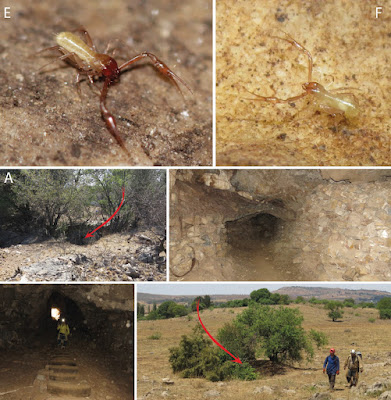Abstract
A new pseudoscorpion species, Selachochthonius naledi sp. nov., is herein described. It can be distinguished from the other species of the genus mainly by the absence of eyes, number and morphology of chelal teeth and coxae setae and by the appendices proportions. This new species represents the fourth record for the genus in South Africa. We also provide some ecological remarks of the new species and recommendations for future research.
Keywords: Cave-dwelling, pseudoscorpion, taxonomy
Family Pseudotyrannochthoniidae Beier, 1932
Genus Selachochthonius Chamberlin, 1929
Selachochthonius naledi sp. nov.
Diagnosis: Selachochthonius naledi sp. nov. differs from other members of the genus by the following combination of characters: absence of eyes or eyespots (S. heterodentatus Beier, 1995 with four well-developed eyes and S. serratidentatus Ellingsen, 1912 bearing four small eyes) (Ellingsen 1912; Beier 1955); epistome triangular and strongly dentate (S. cavernicola Lawrence, 1935 presents a flattened apex and slightly dentated epistome) (Lawrence 1935); palpal femur with length of 0.65–0.66 mm or 6.2 times longer than wide (4.0 times in S. serratidentatus and S. heterodentatus with femur length of 1.0 mm); chela 6.1–6.2 times longer than wide (3.8 times in S. serratidentatus and 5.0 times in S. heterodentatus) (Ellingsen 1912; Beier 1955); fixed finger with 32–34 simple, sparse, acute and triangular teeth (S. cavernicola with 23 sparse, simple and triangular teeth, presented in only 2/3 of the segment; S. heterodentatus with 28 acute teeth intercalated by 24 smaller teeth and S. serratidentatus with sparse, acute and complex teeth, each one intercalated by one or two smaller teeth) (Ellingsen 1912; Lawrence 1935; Beier 1955); movable finger with 29–31 simple, sparse acute and triangular teeth (S. cavernicola with 17 simple, sparse, acute and triangular teeth; S. heterodentatus with 16 acute and triangular, intercalated by 12 smaller teeth) (Lawrence 1935; Beier 1955); presence of a small tubercle in both chelae between the 13th and 14th teeth of the female movable finger and between the 10th and 11th teeth of the male movable finger (S. cavernicola, S. heterodentatus and S. serratidentatus lacks tubercle); 7–11 coxal spines tripinnate arranged in a single row on the anterior portion of the coxa I (S. cavernicola with 12 bipinnate coxal spines) (Lawrence 1935).
Etymology: The epithet naledi refers to Homo naledi, an extinct hominid species discovered within the Dinaledi chamber. This chamber is located in the Rising Star Cave (Fig. 1C), a World Heritage site located approximately 50 km from Johannesburg. The caves where the pseudoscorpions were found are located on the same hill as Rising Star Cave. The distances between the entrance of Rising Star Cave and the entrances of Vila Louise and Yom Tov caves are approximately 425 and 220 meters, respectively. Considering the fissure system associated with the carbonatic rock in the area, it is likely that the pseudoscorpions are able to disperse through small fissures to other macrocaves in the hill, including Rising Star Cave.
Guilherme C. Prado, Gerhard C. Du Preez and Rodrigo L. Ferreira. 2022. Selachochthonius naledi sp. nov. (Pseudoscorpiones, Pseudotyrannochthoniidae), A New Troglobitic Species from South Africa. Subterranean Biology. 42: 125-138. DOI: 10.3897/subtbiol.42.79190


